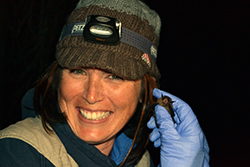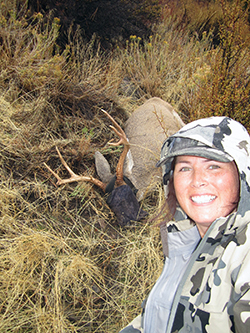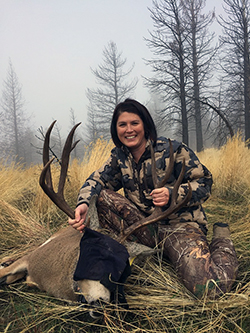


Sara Holm is an environmental scientist with the Wildlife Management Program in CDFW’s North Central Region. Based in Colfax, she is the unit wildlife biologist for Placer and Nevada counties. Her work includes a multi-agency wildlife-crossing project, collared mule deer studies, coordinating the region’s upland game bird hunts, land acquisition and management and many resource assessment projects and surveys. She works primarily with deer, bear, dove, pheasant and turkey but dabbles with lions, elk and bighorn sheep. Critical aspects of her work include responding to wildlife conflicts and providing technical expertise to hunters and the public.
Sara earned a Bachelor of Science degree in Wildlife Management from Humboldt State University in 1999 and started her career two days later as a scientific aide with CDFW. She has worked in the North Central Region for 17 years. She also recently became a hunter education instructor.
What led you into a career as a wildlife biologist?
I credit my family for introducing me to wildlife. The first vacations I can remember were camping, fishing and visiting national parks like Yosemite, Glacier and Yellowstone. There is nothing as exciting as a bear jam (a traffic jam caused by tourists stopping their cars on the side of the road to view bears) in Yellowstone, or that quick flash of a trout taking your fly.
When I was young, I knew I wanted to work outside but all I could envision was being a park ranger. I took a forestry class in junior college but realized that was not quite right for me. My biology professor told me about Humboldt State University and CDFW, so I volunteered with CDFW’s Wildlife Investigations Lab. That is when I realized I could be a wildlife biologist and that I wanted to work for CDFW. It was all fascinating work, whether I was pulling a bear tooth at the front counter, feeding a lion in the pens or responding to a deer stuck in a fence.
I am inspired by the resources and by the chance to make a difference with science. It always made me proud to know I worked for the wildlife as well as the hunters (and anglers). When I complete a great project that I know will help wildlife, or validate a deer tag and talk to another happy outdoor enthusiast, I know that I am in the right place.
What is a typical day like for you at work?
One of the things I like best about my job is that it is never typical! On an office day I may start out answering nuisance wildlife calls, doing paperwork, checking on our collared deer locations or catching up on data entry -- but I could get a call that takes me into the field, to help an injured animal or check damage caused by a bear or lion. When I know I will be in the field the day usually starts early and could take me anywhere in my unit, or throughout the region to help on a colleague’s project.
The work can be hard if you are putting in 14-hour days trying to collar deer and you do not see a single animal, or you come out of the field to 20 messages on your phone, but I would do most of it for free because it is so fun. I have collared tons of deer, put bear cubs out in dens, flown many helicopter surveys, captured bighorn sheep and had many great adventures, but all of the work I do is made better by my fellow biologists. They are a second family to me and we have fun together, whether we are at a meeting or around the campfire. I think everyone should love their job but I am lucky to love the people I work with.
What is your favorite species to interact with or study?
I have a hard time choosing and I am always looking to work with something new. I love seeing fuzzy quail babies in the summer and flushing blue grouse out in the woods but I am more of a mammal person. I mostly work with mule deer and they are more fascinating than they look. Ground darting is anything but routine, as each captured animal is different. It is so exciting to get collar data back and see how and where they moved.
What aspect of working in the Sierra Nevada foothills is unique?
The foothills are interesting, especially considering my unit covers the foothills all the way over the crest of the Sierra to the Tahoe Basin (the elephant in this room is actually a bear!). The most complex part of this area is that there are many people living in urban environments that are actually in rural settings. Communities and pets, including livestock, actually create habitat in areas that are not ideal for wildlife. A pond in the middle of a small town attracts too many geese or maybe invites beavers that then flood roads. Rose bushes attract deer, which draw in lions. People want to raise chickens and then bears walk past homes and across busy roads to eat them. Sometimes I evaluate human-wildlife conflict in a busy city like Auburn, and other times I have to drive an hour out a dirt road for a similar issue.
What is the most rewarding project that you’ve worked on for CDFW?
I am the most proud of my work with the Highway 89 Stewardship Team. Our inter-agency team has built three wildlife crossings with fencing and wildlife jump-outs (which allow animals an exit point if they are within a fence) that are allowing animals to get across the road safely, connecting their habitat and making it safer for drivers. We have mentored other teams and run a successful program for students to teach others about the problems roads cause and the available solutions. These crossings will be in place long after I am gone, so it is a legacy that I can leave on the landscape.
If you had free reign and unlimited funding, what scientific project would you most like to do?
I believe we are currently doing projects that are good science and important for our agency but we could always do them better. I completed a project to evaluate the feasibility of reintroducing desert bighorn sheep to the North Central Region. With enough time, money, and legwork we may be able to clear out the livestock and make it happen. I would love to release some collared animals back in the Truckee River Canyon, spend my days monitoring them and witness their successful return to the area.
Is there a preconception about scientists you would like to dispel?
I guess I would dispel any lasting notions that science is only for men. I work with several other “lady bios” and I am proud of how we operate and the skills that we have. Sometimes when you are talking to the public, they will misconceive what you know or can do just because you are a female. After providing technical assistance I’ve been asked how long I’ve done this job as if to validate my credibility, or I’ve had questions automatically directed at male counterparts even though it’s my area and I’m the one who can answer the question.
Any advice for people considering careers in science or natural resources?
Be persistent and open to opportunity where it is available. We tend not to leave our jobs, so you may have to put in time and wait for something permanent to open up, but you can find a natural resource job in unexpected places like airports or land trusts. Volunteering and meeting people are how I got in. I would advise people to work hard for what they want because this is the best job!